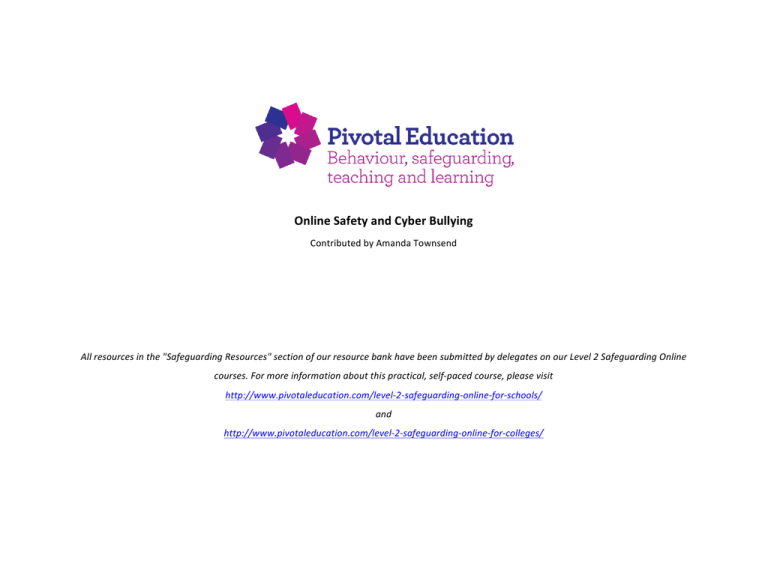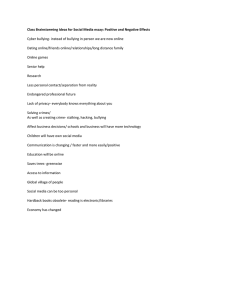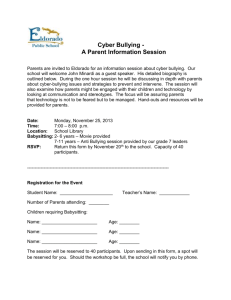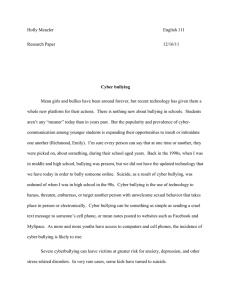Online Safety and Cyber Bullying
advertisement

Online Safety and Cyber Bullying
Contributed by Amanda Townsend
All resources in the "Safeguarding Resources" section of our resource bank have been submitted by delegates on our Level 2 Safeguarding Online
courses. For more information about this practical, self-paced course, please visit
http://www.pivotaleducation.com/level-2-safeguarding-online-for-schools/
and
http://www.pivotaleducation.com/level-2-safeguarding-online-for-colleges/
DO U NO WHO R U TLKG 2?
HOW BIG IS THE PROBLEM?
Cyber based abuse and cyber bullying is a fact of life in schools for both
staff and students but that does not mean we should accept or ignore it.
Mobile phone, e-mail, bulletin boards, social networking sites, message
boards can all be used to threaten and intimidate other people, including
students and staff.
Online bullying is much harder to detect than direct contact in social
settings.
Contact, abuse or bullying that begins online may quickly move offline
TYPES OF CYBER BULLYING
On-line stalking ('cyberstalking') involves the repeated, prolonged, unwanted
texting of or use of electronic messaging and display aimed at a particular
person to harass, intimidate or frighten the recipient.
This may be continuation of other forms of abuse, extending existing bullying
into previously safe and secure settings.
It may be a sole, anonymous form of bullying.
Harassment and stalking usually involves:
Repeated unwanted text, instant messages, or phone calls (including silent
calls).
Use of (message boards, chat rooms) to constantly harass, and/or post
derogatory or defamatory statements or photographs to provoke a response
from the victim (may be referred to as 'flaming').
Tracking targets by using spy-ware.
Sending viruses.
DEFAMATION
Posting upsetting or defamatory remarks about an individual online:
Name-calling using a mobile device.
General insults.
Prejudice-based bullying.
Sexist, homophobic and racist messages.
Attack other kinds of difference (physical or mental disability, cultural or
religious background, appearance or socio-economic position).
Intention - to achieve ostracising/peer-rejection/exclusion.
WHERE BULLYING MAY ARISE
Social networking sites, (Facebook, twitter, Bebo, MySpace) allow an online
presence enabling communication with other network members. Fake accounts
may be set up. Electronic messages or pictures placed on the web where they
may be viewable by millions of people, become difficult to contain.
Gated communities only allowing contact between members.
A group of students can set up a closed group, which can protect them from
unwanted contact. Refusal to return or acknowledge messages, deleting
individual from friendship lists or using 'ignore' functions can be extremely
hurtful.
Video or pictures can be passed between mobile phones either by a local
wireless connection, by text to other phones, uploaded to websites or posted to
public video hosting sites.
RESPONSE
Identifying perpetrators using technology is a difficult, technical and timeconsuming process. Detection may depend on more traditional ways of
investigating incidents — circumstantial evidence, a witness report or an
admission of responsibility.
Parents often do not see it is a problem for children to be on Facebook for
example. Reports brought to the teacher to deal with children being
victimised on FB.
STAY SAFE ON LINE!






